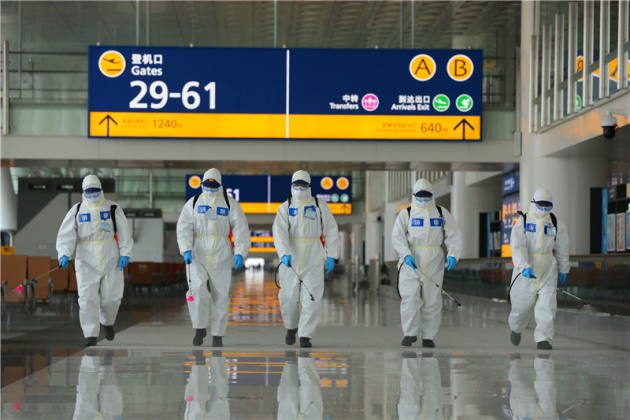Retro: These events marked aviation in 2020
Air transport and aeronautics are two sectors that have been hit hard by the coronavirus crisis. To fight against the spread of the virus, flight suspensions and travel restrictions (including lockdowns) have been taken, leading to a sharp drop in demand.
 |
| Wuhan airport desinfection during the COVID-19 pandemic |
Several fatal crashes
On January 8, 2020, a Boeing 737-800 of Ukraine International Airlines was shot down after taking off from Tehran, Iran, killing 167 passengers and 9 crew members.
A C-130 Hercules crashed during a firefighting operation in Australia, killing three people.
On February 5, a Boeing 737-800 belonging to the Turkish company Pegasus Airlines skidded off the runway at Istanbul Sabiha Gökçen Airport after landing, killing three people.
 |
| The Boeing 737-800 after the crash (credits:AFP) |
On May 22, 2020, an Airbus A320 operating Pakistan International Airlines Flight 8303 crashed near Karachi Airport. Of the 91 passengers and 8 crew members, 97 were killed.
On August 7, an Air India Boeing 737 left the runway of Calicut airport in India, killing 2 pilots and 18 passengers.
The coronavirus pandemic
On January 23rd, Wuhan Airport in China closes and only a few flights are maintained. Planes carrying medical and rescue personnel arrived in the Hubei region. Air traffic is paralyzed.
These airlines have ceased operations
On March 11, the United States announced a ban on passengers coming from the Schengen area in Europe. The restrictions put in place to fight the spread of the coronavirus impacted airlines. Some of them went bankrupt. Others survive thanks to emergency financial aid from the States.
 |
| Air France aircraft grounded |
In China, air traffic has gradually resumed since April. In Wuhan, the airport reopens on April 8, 2020. A health protocol is created to guarantee flight safety.
To face the epidemic, airlines are considering, in addition to the mandatory wearing of masks, UV disinfection systems or rapid tests before boarding. Air Canada has signed an agreement with a company specializing in COVID-19 tests.
Aeronautics affected by the pandemic
With the pandemic and falling demand, airlines are forced to postpone deliveries and even cancel orders. Production rates have been reduced. Consequences are noticeable throughout the value chain, with suppliers of parts for Airbus also impacted. Engine manufacturers like Safran are showing their concern about the situation.
 |
| The Airbus factory assembly line (credits:Airbus) |
On March 17, Airbus announced a production shutdown for several days to implement a health protocol. In early April, Airbus shut down production and assembly operations at its German sites in Bremen (April 6 to 27) and Stade (April 5 to 11), as well as the Mobile plant in the United States, which assembles A320 and A220 aircraft (until April 29).
On the other side of the Atlantic, Boeing decided to close its plants at the beginning of April. Assembly lines in Washington State and Charleston, South Carolina are affected.
The Bombardier industrial group leaves the commercial aircraft sector on February 12 by selling the A220 program to Airbus.
Also in the aviation news, April 25 marks the end of the joint venture project between Boeing and Brazilian aircraft manufacturer Embraer.
777X and 737 MAX for Boeing
The Boeing 777X makes its first flight on January 25, 2020. The new long-haul aircraft features new innovations such as fold-out aids and General Electric engines. The aircraft can carry up to 426 passengers over a distance of 16,170 km and 13,500 km for both versions: 777-8 and 777-9.
On November 18, the FAA cleared the Boeing 737 MAX to return to flight after nearly two years on the ground. Brazilian airline Gol and American Airlines were among the airlines to return the aircraft to service first.
The end of production of the Boeing 747 is confirmed for 2022.
News from Russian and Asian manufacturers
The aircraft manufacturer COMAC is continuing its development and is preparing for the certification of its C919 medium-haul aircraft, which should take place in early 2021 in China. The aircraft manufacturer aims to compete with the Boeing 737 and the Airbus A320.
In Russia, my first version of the MC-21 equipped with Russian-made PD-14 engines made its first flight.
Air cargo has become central to airlines
Cargo activity surged with the increase in demand for the transport of masks and other sanitary equipment. The most impressive aircraft such as the Antonov 225 were mobilized, as well as converted passenger aircraft. Portuguese charter operator Hi Fly, for example, transformed its A380 into a cargo aircraft. According to IATA, cargo flights should account for 36% of airline revenues in 2020. The association also forecasts that air freight will account for one third of airline revenues in 2021.
 |
| An Airbus A350 carries masks (credits:Airbus) |
Aircraft storage has also become a recurring issue. Airports around the world have had to build up giant storage areas.
Conclusion
The year 2020 has left a profound mark on aviation. Air transport continues to go through a serious crisis and transformations are taking place. The collapse of some airlines, the development of air freight and business air transport, the rapid renewal of fleets with less CO2-emitting aircraft and possible mergers are trends currently observed in the aviation industry.
Other trends are being amplified: in the aeronautics sector, the factory of the future with the integration of more robots and for airlines, the desire to reduce the share of wide-body aircraft (A340, A380, 747) and to simplify fleets.



